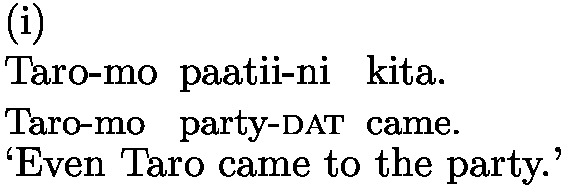Abstract
This paper offers a granularity-based account of the fact that round and non-round numbers may exhibit polarity effects when they are appended by even-type focus particles. The key observation is that non-round numbers appended by mo ‘even’ in Japanese cannot be in the scope of negation, while round numbers exhibit no restriction in scopal relation. Adopting the scope theory of mo and a theory of granularity ([6, 10]), we propose that an asymmetric entailment relation holds between propositions with a non-round and a round number and this entailment relation invites a proposition with a coarser granularity into the set of alternatives in computing the scalar presupposition of mo. Given that the scalar presupposition of mo with numerals is only sensitive to asymmetric entailment, we argue that the availability of asymmetric entailment from the prejacent to this additional alternative proposition is responsible for the polarity effects. We also discuss the related issues such as polarity effects observed in explicit approximators (e.g. about, approximately) and numerals with the contrastive topic marker wa.
We would like to express our gratitude to Stephanie Solt and anonymous reviewers of LENLS 19 for their invaluable comments on an earlier version of the paper. This work is supported by JSPS Grant-in-Aid 21K00525.
Access this chapter
Tax calculation will be finalised at checkout
Purchases are for personal use only
Notes
- 1.
Mo has several usages as exemplified below. We will confine ourselves to the scalar usage with a similar meaning to ‘even’ in this paper. We do not make any specific assumption about the issue of whether these different usages come from a single source or not.

.
- 2.
- 3.
Nakanishi [8, 185] notes that the large-number reading is indeed not impossible in English, as shown in (i):
(i) Al, Bill and Conan always read everything they are assigned, but this time, they each had some books that they didn’t read. Al didn’t read
 book, Bill didn’t read
book, Bill didn’t read
 books and Conan ended up not even reading
books and Conan ended up not even reading
 .
. - 4.
- 5.
Even-items including mo may also introduce an additive presupposition (=(i)), but we will put this component aside in this paper.

.
- 6.
We do not claim that the unlikeliness of mo is always based on asymmetric entailment: this simply makes a wrong prediction. In (i), for example, it has to be the case that Taro came to the party is less expected than, say, Mary came to the party, which is not in entailment relation with the former.

What seems to be the case is that in the case of mo appended to numerals, the unlikeliness based on other than asymmetric entailment is not available.
- 7.
In footnote 2 we pointed out that (2b) has the third reading. The scopal relation involved in this reading should be [\(\lnot>\) mo > n]. This apparent inconsistency to what we claim here is resolved if we consider this reading to be actually a case of external negation. A piece of evidence for this view comes from the fact that this use requires a preceding discourse that refers to the number, as in (i).
(i) A: How many students are enrolled in your class this semester? 50 students have enrolled in mine.
B:

.
- 8.
See [12] for morpho-syntactic reasoning of this obligatory wide-scope reading of focus particles.
References
Goncharov, J., Wolf, L.: Deriving polarity from granularity. In: Proceedings of SALT, vol. 31, pp. 683–702 (2021)
Hara, Y.: Grammer of Knowledge Representation: Japanese Discourse Items at Interfaces. Ph.D. thesis, University of Delaware (2006)
Ijima, M.: Suuryooshi to wa to mo (quantifiers and wa and mo). In: Tsukishima Hiroshi sensei koki kinen kokugogaku ronshu (A Festschrift for Professor Hiroshi Tsukishima on his 70th birthday), pp. 1041–1062. Kyuuko shoin (1995)
Karttunen, L., Peters, S.: Conventional implicature. Syntax Semant. 11, 1–56 (1979)
Katzir, R.: Structurally-defined alternatives. Linguist. Philos. 30, 669–690 (2007)
Krifka, M.: Approximate interpretations of number words: a case for strategic communication. In: Hinrichs, E., Nerbonne, J. (eds.) Theory and evidence in semantics, pp. 109–132. CSLI Publications, Stanford (2009)
Nakanishi, K.: Even, only, and negative polarity in Japanese. In: Proceedings of SALT, vol. 16, pp. 138–155 (2006)
Nakanishi, K.: Scope of Even: A cross-linguistic perspective. In: Proceedings of NELS , vol. 38, pp. 179–192 (2009)
Nakanishi, K.: Focus particle ‘mo’ appended to numerals and negation (suushi toritate-no ‘mo’ to hitei). In: Kato, Y., Yoshimura, A., Imani, I. (eds.) Negation and Linguitic Theory (Hitei to Gengo Riron), pp. 260–284. Kaitakusha (2010)
Sauerland, U., Stateva, P.: Scalar vs. epistemic vagueness: evidence from approximators. In: Proceedings of SALT, vol. 17, pp. 228–245 (2007)
Sawada, O.: The Japanese contrastive Wa: a mirror image of EVEN. In: Proceedings of Berkeley Linguistic Society, vol. 34, pp. 281–292 (2008)
Shibata, Y.: Negative structure and object movement in Japanese. J. East Asian Linguis. 24(3), 217–269 (2015). https://doi.org/10.1007/s10831-014-9131-9
Solt, S.: An alternative theory of imprecision. In: Proceedings of SALT, vol. 24, pp. 514–533 (2014)
Solt, S.: Approximators as a case study of attenuating polarity items. In: Hucklebridge, S., Nelson, M. (eds.) Proceedings of NELS, vol. 48, pp. 91–104 (2018)
Author information
Authors and Affiliations
Corresponding author
Editor information
Editors and Affiliations
Rights and permissions
Copyright information
© 2023 The Author(s), under exclusive license to Springer Nature Switzerland AG
About this paper
Cite this paper
Tanaka, E., Mizutani, K. (2023). Granularity in Number and Polarity Effects. In: Bekki, D., Mineshima, K., McCready, E. (eds) Logic and Engineering of Natural Language Semantics. LENLS 2022. Lecture Notes in Computer Science, vol 14213. Springer, Cham. https://doi.org/10.1007/978-3-031-43977-3_4
Download citation
DOI: https://doi.org/10.1007/978-3-031-43977-3_4
Published:
Publisher Name: Springer, Cham
Print ISBN: 978-3-031-43976-6
Online ISBN: 978-3-031-43977-3
eBook Packages: Computer ScienceComputer Science (R0)



 book, Bill didn’t read
book, Bill didn’t read
 books and Conan ended up not even reading
books and Conan ended up not even reading
 .
.


